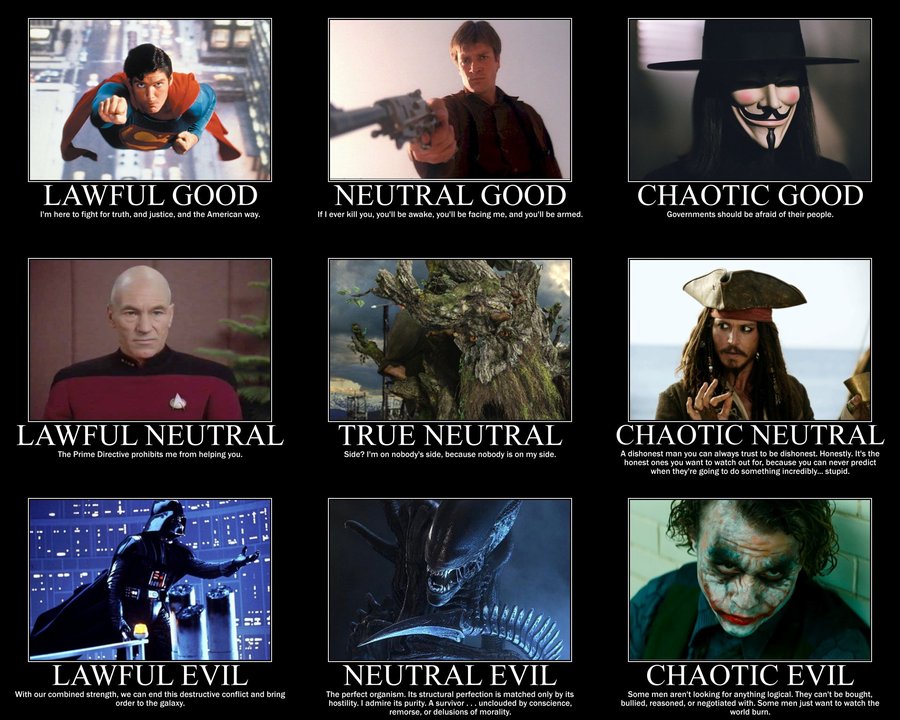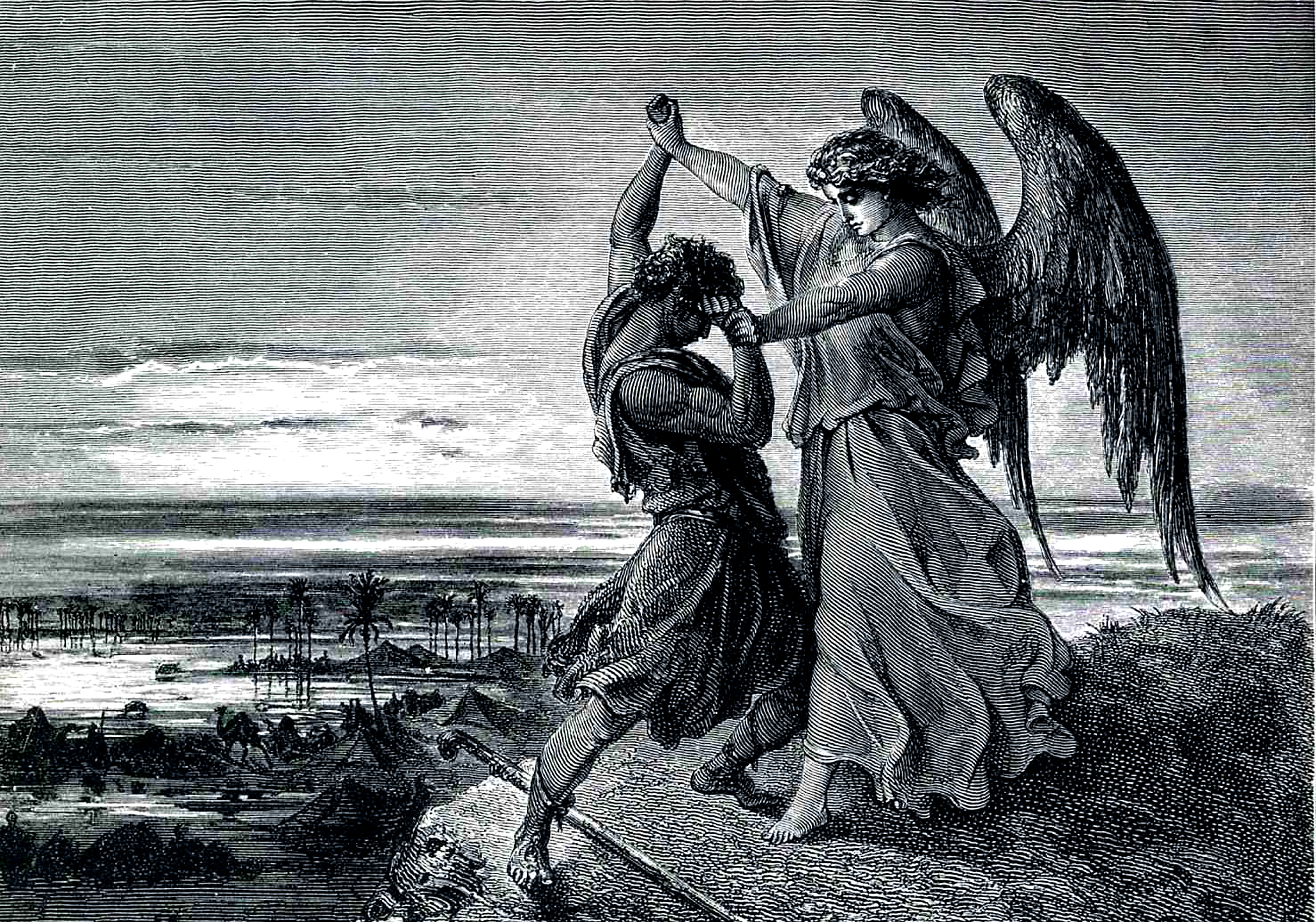There is an artifact in D&D far more insidious than any part of Vecna or Blackrazor. The concept of Alignment is an artifact of the early game and it is filled with problems. It is time to either radically change it or get rid of it altogether.
The Origins.
The origin of Alignment goes back to the early days of D&D, but it does change over time. The concept was actually taken from the works of Michael Morcock and Poul Anderson.
Three Hearts and Three Lions by Anderson does a fine job of presaging the Paladin and Trolls as described in D&D, but it also gives us this idea of a cosmic axis of Chaos and Order or Law. Moorcock of course does the same with Elric and the related characters.
The first iteration of the game only had three alignments. On page 9 of the first book in the Original Dungeons and Dragons:
Before the game begins it is not only necessary to select a role, but it is also necessary to determine what stance the character will take — Law, Neutrality, or Chaos.
Gygax, G. (1976). Dungeons and dragons (1st ed., Vol. 1, p. 9). Place of publication not identified: Tactical Studies Rules
It wasn’t till later publications that the Evil and Good were added to the mix. This vision of the Alignment is still sort of grounded in that cosmic axis, but as alignment becomes more of a requirement for classes like Paladin, it gets applied more broadly as a moral gauge. It also become problematic when talking about the non-human races.
Drow, Orcs, and others are not just aligned with a particular force but are considered morally evil, by nature. The problem of the “evil” races starts here and D&D is only now beginning to dig out from underneath that issue.
As the game evolved, alignment became more and more important with an abstracted, gamified, version of morality that comes with it. Towards the end of the 3rd edition era, that began to change some. Eberron certainly started to erase the dependence on it by making normally monstrous races more human in their moral and emotional range. By 5th edition, the importance of Alignment to the overall system of D&D has reduced significantly. It is still there, though. It still comes up in every D&D circle I can name.
The Problems
Alignment, as it came to be understood in D&D, comes with a few problems.
First, it tries to abstract a deeply complex subject, morality, into a gamable system. Moral philosophy has been the subject of debate since the beginning of philosophy. Hell, I could spend days writing 100,000 words and still not really grab all the nuances. People like Socrates, Confucius, Jeremy Bentham, and Emanual Kant discussed it extensively and there is still much debate as to what qualifies as objective good and objective evil.

That doesn’t even include the religions, so you are going to measure moral realms with a 9 block square? That is just ridiculous.
It leads to that most ridiculous of conversation, is this fictional villain actually good? I saw it recently with Thanos but there are others. There were actually people that argued that Thanos, the genocidal madman, was in fact Lawful Neutral in game terms. This is an extension of the earlier editions locking people out of certain things if they strayed out of a particular alignment. Suddenly, you had rules lawyers arguing a whole range of behaviors fell within Lawful Good so they could keep their cool powers.
Beyond that, people don’t want to admit they are playing bad guys. They will argue the definition of “lawful good” is somehow relative and so a nazi like racial cleansing campaign is fine because society says so. They want to say they rob, steal, and murder but that is okay because they are actually this heavily bent definition of chaotic good.
The other really big issue with Alignment is one that Wizards of The Coast is beginning to work on changing. The notion of the “evil” races. Drow and Orcs are the usual example and the most problematic. Orcs and Drow are capable of thoughts and emotions. They are basically human like, but they are described as evil in term that strongly resembles the way 19th century white people talked about natives or black people.
It reads as only slightly cloaked real world racism. That was made worse by the lack of diversity in D&D art for its first decade or two. If the only black characters you show are part of an in inherently evil race, it is kind of hard to not see that as racist. Even the “one good Drow” trope just reinforces that feeling.
Note: I don’t for an instant think the designers had racism in mind. They were just populating the game with bad guys and it didn’t occur to them what they were doing. People are not always aware of the mistakes they are making.
The Fixes
Well, the first, easiest, and most obvious solution is get rid of Alignment altogether. The game almost never uses it anymore on a system level. Just delete it from your vocabulary and move on. You don’t need it and you can return to looking at what people do in-game the way we do in the real world.
No?
Okay some people will want to keep some part of Alignment for lore reasons and it feels familiar. If you want to keep it, there are a couple of things to do.
First, reduce it to Chaos, Neutral, and Lawful. Get rid of the evil and good axis. That is not to say evil and good don’t matter, but making it a moral gauge is what causes so many problems. Instead, return it to the notion that your alignment is what cosmic force you are aligned with. Order or Chaos or somewhere in between? Most sentient people in any given game world would be in between.
Second, it is only for non mortal things. Gods, Angels, Devils, Demons, Fey, and all those extra planar things are the only ones that are actually, by nature, anything. These are concepts that have coalesced into beings. They are not born, raised, and lived like a mortal. Those are the only things it matters too.
But but Evil…
Look, it is hard to find an actual objective definition of evil that always applies. We instead can point to actions. Hurting kids on purpose? That is evil. Genocide? Evil. Evil is in an action, not in the nature of person. Eliminating evil as an alignment doesn’t eliminate evil, it just gets rid of the justification.
Beasts, are not evil but can still be a threat. You don’t need a dragon to be aligned with evil to know it did evil things. It means you can say the gold dragon did evil things, or the red dragon is a philanthropist. You are no longer judging them as a type but by their actions.
Removing the evil or good alignment doesn’t limit your choices of bad guys. It increases it. You decide to make a group evil by doing evil things. The justification for fighting them is the stuff they do rather than how they are born. It is a liberating thing and DM’s should embrace it.
